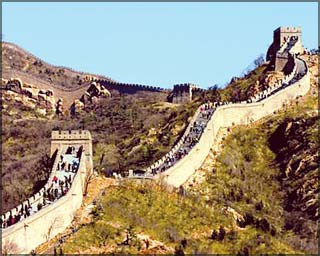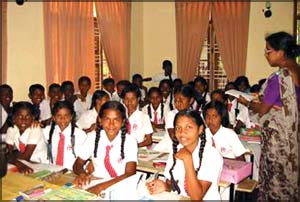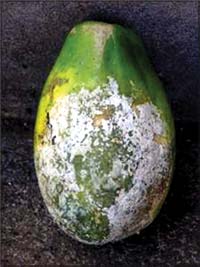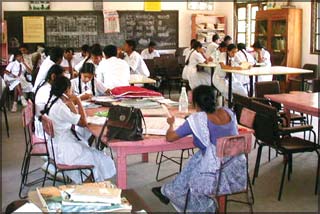|

Great Wall of China far longer than
thought
The most comprehensive and technologically advanced survey of China’s
Great Wall has discovered that the ancient monument is much longer than
previously estimated, according to a media report.
However, the project has also shown the World Heritage-listed site is
in danger of disappearing in many places due to road construction and
other forms of development including weather.

The wall, built over centuries to keep foreigners out of China,
stretches for 8,851.8 kilometres (5,488.1 miles), much further than
common estimates of 5,000 kilometres, according to the findings of the
survey.
The defensive structure includes 6,259.6 kilometres of actual wall,
plus 359.7 kilometres of trenches and 2,232.5 kilometres of natural
barriers such as hills and rivers. The two-year mapping project, carried
out by the State Administration of Cultural Heritage, involved using
global positioning systems and infra-red technology.
Previous estimates were mainly based on historical records, rather
than physically mapping each section.
By tracking thoroughly across mountains and through deserts, unknown
parts were uncovered.
The first parts of the Great Wall were built more than 2,000 years
ago, then rebuilt and extended during the Ming Dynasty (1368 to 1644 AD)
amid the threat of invading northern tribes.
In recent times, the wall has suffered extensively at the hands of
modern development, with sections of it destroyed to make way for roads
and other forms of construction.
The survey was part of a 10-year conservation project launched in
2005 that will now be able to keep detailed maps of the sections of the
wall that need to be protected, and to maintain records of efforts to
renovate or preserve it.
Popular beliefs claimed that the Great Wall is “the mightiest work of
man, the only one that would be visible to the human eye from the moon”.
Arthur Waldron, author of The Great Wall of China: From history to
Myth, has speculated that the belief might go back to the fascination
with the ‘canals’ once believed to exist on Mars.
President keen to uplift education
in South
Following a directive by President Mahinda Rajapkasa to the Southern
Province Governor Kumari Balasuriya, the School Principals have been
informed to reply with immediate effect, to the relevant Education
Office, when they are asked to provide information about their schools.
 A
meeting was organised in Galle recently to discuss the prevailing
shortcomings in schools, due to shortage of teachers in those schools.
Galle and Matara areas are reportedly having an excess of teachers. It
was noted that not a single child had passed last year’s Grade 5
Scholarship examination from the Yakkalamulla area. A
meeting was organised in Galle recently to discuss the prevailing
shortcomings in schools, due to shortage of teachers in those schools.
Galle and Matara areas are reportedly having an excess of teachers. It
was noted that not a single child had passed last year’s Grade 5
Scholarship examination from the Yakkalamulla area.
There have been occasions where some teachers sought transfers just
after six or eight months of their first appointment. In future, the
outcome of this situation would be informing the Chief Minister, for his
information.
The Governor said National Schools in the Province are full of excess
teachers. “Vast expenditure on education is a must for our
consideration,” she noted. Education, like most other essential sectors
of the polity, which are considered prime recipients of Lankan welfare
expenditure, has suffered considerable neglect in the past few years.
Imbalances in the system of education have led to grave social
inequalities. Besides, socio-economic development is inconceivable
without the necessary human resources, which only the education system
could produce. It is a heartening development that this problem of
overstaffing is receiving the attention of the President himself.
Flies from
Puerto Rico
A species of flies known as parasitoids will be brought from Puerto
Rico to control the spread of mealy bug Parasitoids or Piti makuna on
papaw and vegetable plantations.

The programme to bring the parasitoids is funded by the United States
Agriculture Department.
According to Head of Division of Entomology, Horticultural Crops
Research and Development Institute, Indra Wahundeniya this is the first
time that the mealy bug has affected papaw and vegetable cultivations in
Sri Lanka.
The best control method is parasi-toids as tried out in many
countries. These insects are known to lay eggs on cultivations affected
by the mealy bug and have a four stage life cycle. Once the life cycle
is complete, the mealy bug will reduce in numbers.
Fifty thousand parasitoids brought down will be kept in laboratories
to multiply and others released to badly affected areas in the island.
A parasitoid is an organism that spends a significant portion of its
life attached to or within a single host organism which it ultimately
kills (and often consumes) in the process. Thus they are similar to
typical parasites except in the certain fate of the host. In a typical
parasitic relationship, the parasite and host live side by side without
lethal damage to the host.
CSDP to conduct environment competition
The Child Skills Development Programme (CSDP) which completes 14
years on June 14 this year will conduct competitions to mark World
Environment Day which falls on June 5.
The competition which is open to school children under two
categories-above 12 years and below 12 years will comprise events such
as art, poetry, lyric writing, dancing, short dramas, announcing and
singing.Awards will also be presented to 100 child environmentalists on
this day.Those interested in participating can contact the CSDP by
calling on 0112-672718 or 0112-689536 or through their website -
www.csdpsrilanka.org.
Libraries for
IDP children
A new project to construct libraries for schoolchildren of internally
displaced persons (IDPs) will be implemented shortly in Vavuniya, Jaffna
and Mannar districts. These
 will
be set up under the three task forces appointed by the Resettlement and
Disaster Relief Services Minister, Rishard Bathiudeen, to look into the
smooth functioning of health, food and education facilities of over
68,000 IDPs who have crossed over to liberated areas from the LTTE
clutches. will
be set up under the three task forces appointed by the Resettlement and
Disaster Relief Services Minister, Rishard Bathiudeen, to look into the
smooth functioning of health, food and education facilities of over
68,000 IDPs who have crossed over to liberated areas from the LTTE
clutches.
According to the Minister, the establishment of pre-schools for
children, especially those who were deprived of attending schools for
several years due to unfavourable conditions will also be undertaken by
these task forces.
A large number of IDPs are expected to come from uncleared areas and
Government will have to allocate a large sum of money to provide them
with necessary facilities including education for children.
Libraries are more than just books. Technology has transformed
libraries from book warehouses to information centres. As institutions
of social service, libraries offer a wide range of self-improvement
programmes and services to the students.
Today is World
Press Freedom Day
The World Press Freedom Day is celebrated on May 3 as declared by the
United Nations General Assembly, to raise awareness of the importance of
freedom of the press and remind governments of their duty to respect and
uphold the right to freedom of expression enshrined under Article 19 of
the Universal Declaration of Human Rights, and also mark the Anniversary
of the Declaration of Windhoek.
UNESCO marks World Press Freedom Day by conferring the
UNESCO/Guillermo Cano World Press Freedom Prize on a deserving
individual, organisation or institution that has made an outstanding
contribution to the defence and/or promotion of press freedom anywhere
in the world, especially when this has been achieved in the face of
danger. Created in 1997, the prize is awarded on the recommendation of
an independent jury of 14 news professionals.
Names are submitted by regional and international non-governmental
organisations working for press freedom, and by UNESCO member states.
The Prize is named in honour of Guillermo Cano Isaza, a Colombian
journalist who was assassinated in front of the offices of his
newspaper, El Espectador, in Bogot, on December 17, 1986. Cano’s
writings had offended Colombia’s powerful drug barons.
UNESCO also marks World Press Freedom Day each year by bringing
together media professionals, press freedom organisations and UN
agencies to assess the state of press freedom worldwide and discuss
solutions for addressing challenges.
The potential of media in fostering dialogue, mutual understanding
and reconciliation will be the topic of UNESCO World Press Freedom Day
2009.
Birth and death anniversaries from
May 1 - May 9
May 1
Death of President Premadasa in 1993.
May 2
Death of Leonardo Da Vinci, Italian artist in 1519.
May 4
Death of Dr. Wijayananda Dahanayake Sri Lanka’s fifth Prime
Minister, in 1997.
May 5
Birth of Karl Marx in 1818.
Death of Napoleon Bonaparte in 1821.
Death of Sir James Peiris, national hero of Sri Lanka, in 1930.
May 6
Birth of Robert Peary, American explorer - first man to reach the
North Pole in 1856.
May 7
Birth of Robert Browning, English poet in1812.
May 9
Birth of Tissa Ranasinghe, sculptor in 1925.
Special events which took place in
history, from May 1 - May 9
May 1
May Day designated as International Labour Day by the International
Socialist Congress in 1889.
First May Day rally in Sri Lanka organised by A. E. Goonasinha in 1933.
Grama Sevaka system replaced the Village Headmen System in 1963.
May 2
Railway to Trincomalee was inaugurated in 1927.
New Town Hall in Colombo was declared open in 1928.
May 7
The Establishment of the Fort in Colombo by Portuguese in 1518.
Saradiel the outlaw was hanged in 1864.
May 8
Red Cross Day
May 9
Official end of World War II in 1945.
Laying of the foundation stone for the Sapugaskanda Oil Refinery in
1967. |

